Global Policy Review: Non-Communicable Diseases Challenge Report
VerifiedAdded on 2022/11/14
|20
|4711
|82
Report
AI Summary
This report provides a comprehensive overview of the global challenge posed by Non-Communicable Diseases (NCDs), analyzing the current policy landscape and proposing recommendations for effective control. The report begins with an introduction highlighting the global prevalence and impact of NCDs, including cardiovascular diseases, cancer, diabetes, and chronic respiratory illnesses. It then delves into the challenge of NCDs, emphasizing their disproportionate burden on low- and middle-income countries and their threat to sustainable development. The report examines the need for an action plan, the policy framework, and objectives of the strategic framework. It also addresses the challenges of policy actions, offering specific recommendations for improvement, and concludes with a summary of key findings. The report also includes the evolution of global policy on NCD prevention and control, key issues that need to be addressed, key global actors, milestones, principles, and approaches used in NCD policy, NCDs in the Sustainable Development Goals (SDGs), the role of global versus national policy and the importance of national policy, coordination and monitoring mechanisms, and key documents on NCD policy.

Global Challenge: Non-Communicable Diseases 1
GLOBAL CHALLENGE: NON-COMMUNICABLE DISEASES
by
Student
Name
Course
Professor
Institution
Date
GLOBAL CHALLENGE: NON-COMMUNICABLE DISEASES
by
Student
Name
Course
Professor
Institution
Date
Paraphrase This Document
Need a fresh take? Get an instant paraphrase of this document with our AI Paraphraser
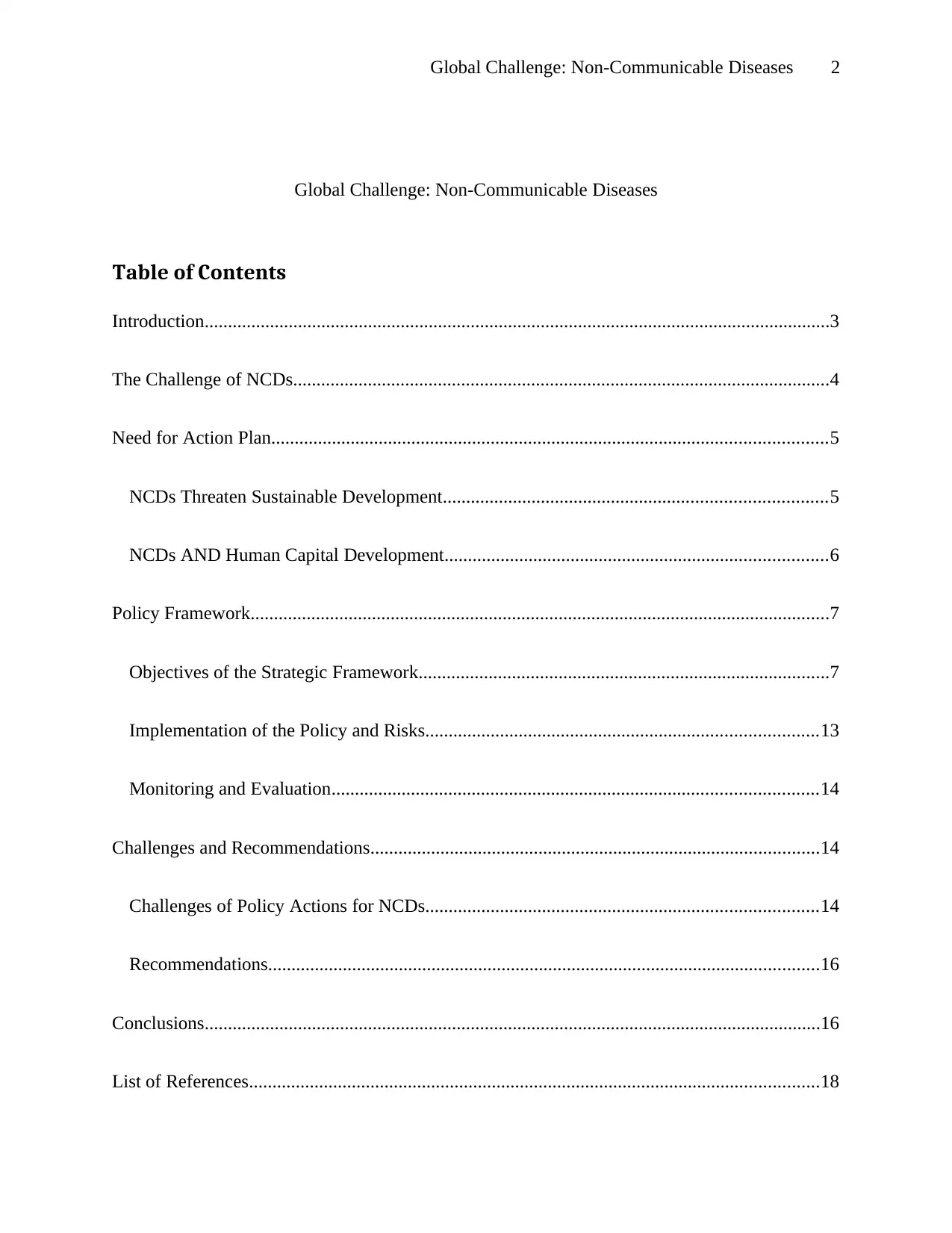
Global Challenge: Non-Communicable Diseases 2
Global Challenge: Non-Communicable Diseases
Table of Contents
Introduction......................................................................................................................................3
The Challenge of NCDs...................................................................................................................4
Need for Action Plan.......................................................................................................................5
NCDs Threaten Sustainable Development..................................................................................5
NCDs AND Human Capital Development..................................................................................6
Policy Framework............................................................................................................................7
Objectives of the Strategic Framework........................................................................................7
Implementation of the Policy and Risks....................................................................................13
Monitoring and Evaluation........................................................................................................14
Challenges and Recommendations................................................................................................14
Challenges of Policy Actions for NCDs....................................................................................14
Recommendations......................................................................................................................16
Conclusions....................................................................................................................................16
List of References..........................................................................................................................18
Global Challenge: Non-Communicable Diseases
Table of Contents
Introduction......................................................................................................................................3
The Challenge of NCDs...................................................................................................................4
Need for Action Plan.......................................................................................................................5
NCDs Threaten Sustainable Development..................................................................................5
NCDs AND Human Capital Development..................................................................................6
Policy Framework............................................................................................................................7
Objectives of the Strategic Framework........................................................................................7
Implementation of the Policy and Risks....................................................................................13
Monitoring and Evaluation........................................................................................................14
Challenges and Recommendations................................................................................................14
Challenges of Policy Actions for NCDs....................................................................................14
Recommendations......................................................................................................................16
Conclusions....................................................................................................................................16
List of References..........................................................................................................................18
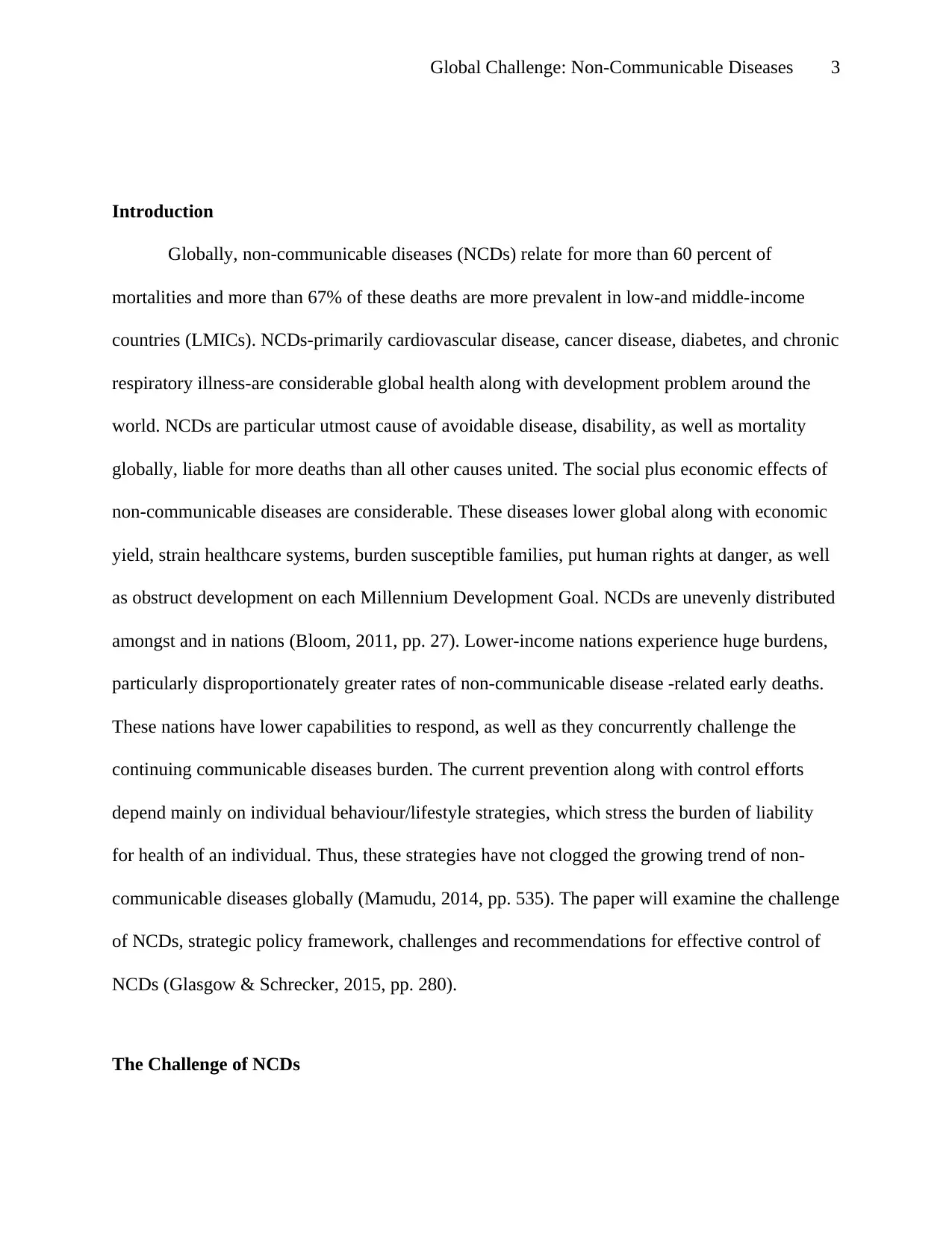
Global Challenge: Non-Communicable Diseases 3
Introduction
Globally, non-communicable diseases (NCDs) relate for more than 60 percent of
mortalities and more than 67% of these deaths are more prevalent in low-and middle-income
countries (LMICs). NCDs-primarily cardiovascular disease, cancer disease, diabetes, and chronic
respiratory illness-are considerable global health along with development problem around the
world. NCDs are particular utmost cause of avoidable disease, disability, as well as mortality
globally, liable for more deaths than all other causes united. The social plus economic effects of
non-communicable diseases are considerable. These diseases lower global along with economic
yield, strain healthcare systems, burden susceptible families, put human rights at danger, as well
as obstruct development on each Millennium Development Goal. NCDs are unevenly distributed
amongst and in nations (Bloom, 2011, pp. 27). Lower-income nations experience huge burdens,
particularly disproportionately greater rates of non-communicable disease -related early deaths.
These nations have lower capabilities to respond, as well as they concurrently challenge the
continuing communicable diseases burden. The current prevention along with control efforts
depend mainly on individual behaviour/lifestyle strategies, which stress the burden of liability
for health of an individual. Thus, these strategies have not clogged the growing trend of non-
communicable diseases globally (Mamudu, 2014, pp. 535). The paper will examine the challenge
of NCDs, strategic policy framework, challenges and recommendations for effective control of
NCDs (Glasgow & Schrecker, 2015, pp. 280).
The Challenge of NCDs
Introduction
Globally, non-communicable diseases (NCDs) relate for more than 60 percent of
mortalities and more than 67% of these deaths are more prevalent in low-and middle-income
countries (LMICs). NCDs-primarily cardiovascular disease, cancer disease, diabetes, and chronic
respiratory illness-are considerable global health along with development problem around the
world. NCDs are particular utmost cause of avoidable disease, disability, as well as mortality
globally, liable for more deaths than all other causes united. The social plus economic effects of
non-communicable diseases are considerable. These diseases lower global along with economic
yield, strain healthcare systems, burden susceptible families, put human rights at danger, as well
as obstruct development on each Millennium Development Goal. NCDs are unevenly distributed
amongst and in nations (Bloom, 2011, pp. 27). Lower-income nations experience huge burdens,
particularly disproportionately greater rates of non-communicable disease -related early deaths.
These nations have lower capabilities to respond, as well as they concurrently challenge the
continuing communicable diseases burden. The current prevention along with control efforts
depend mainly on individual behaviour/lifestyle strategies, which stress the burden of liability
for health of an individual. Thus, these strategies have not clogged the growing trend of non-
communicable diseases globally (Mamudu, 2014, pp. 535). The paper will examine the challenge
of NCDs, strategic policy framework, challenges and recommendations for effective control of
NCDs (Glasgow & Schrecker, 2015, pp. 280).
The Challenge of NCDs
⊘ This is a preview!⊘
Do you want full access?
Subscribe today to unlock all pages.

Trusted by 1+ million students worldwide
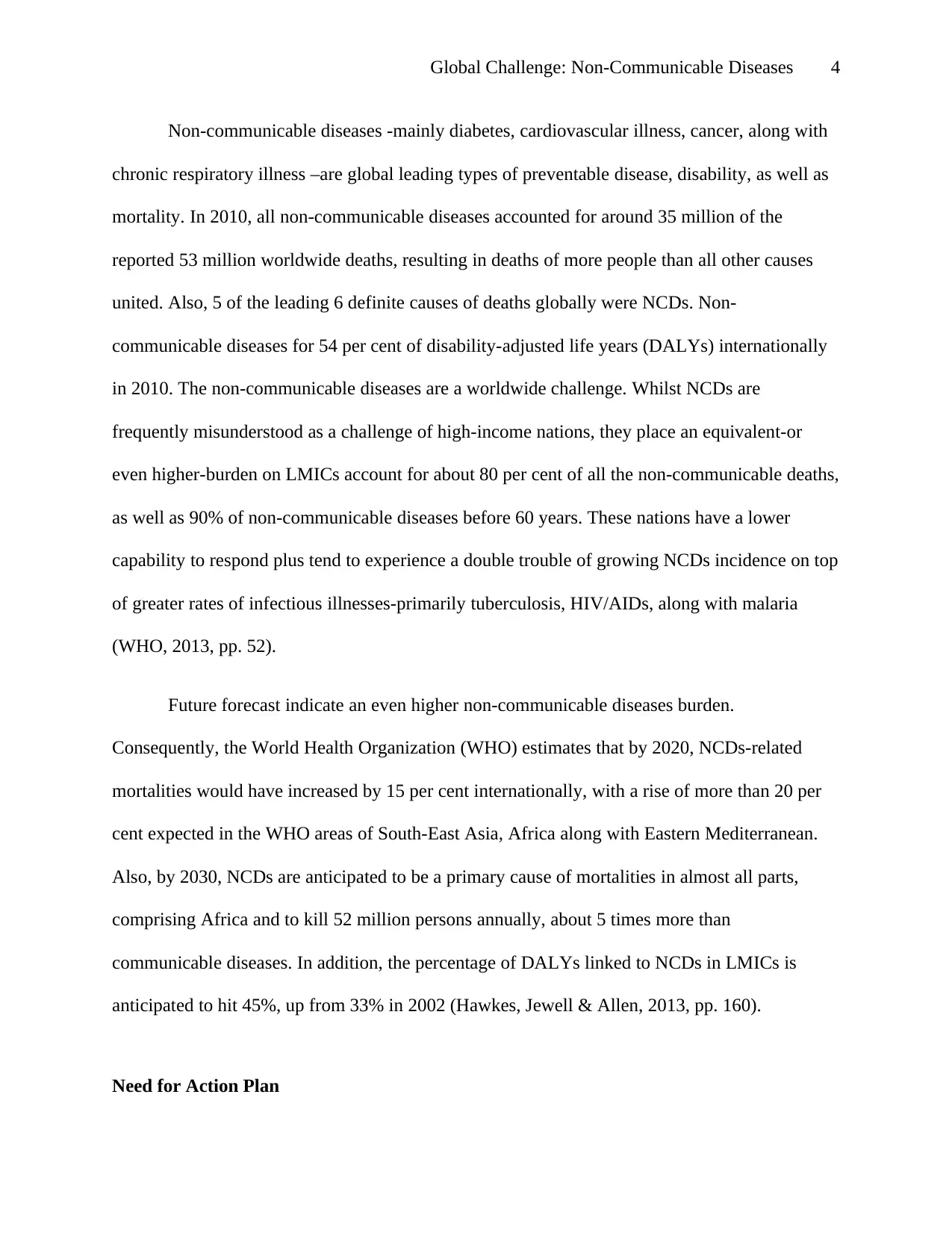
Global Challenge: Non-Communicable Diseases 4
Non-communicable diseases -mainly diabetes, cardiovascular illness, cancer, along with
chronic respiratory illness –are global leading types of preventable disease, disability, as well as
mortality. In 2010, all non-communicable diseases accounted for around 35 million of the
reported 53 million worldwide deaths, resulting in deaths of more people than all other causes
united. Also, 5 of the leading 6 definite causes of deaths globally were NCDs. Non-
communicable diseases for 54 per cent of disability-adjusted life years (DALYs) internationally
in 2010. The non-communicable diseases are a worldwide challenge. Whilst NCDs are
frequently misunderstood as a challenge of high-income nations, they place an equivalent-or
even higher-burden on LMICs account for about 80 per cent of all the non-communicable deaths,
as well as 90% of non-communicable diseases before 60 years. These nations have a lower
capability to respond plus tend to experience a double trouble of growing NCDs incidence on top
of greater rates of infectious illnesses-primarily tuberculosis, HIV/AIDs, along with malaria
(WHO, 2013, pp. 52).
Future forecast indicate an even higher non-communicable diseases burden.
Consequently, the World Health Organization (WHO) estimates that by 2020, NCDs-related
mortalities would have increased by 15 per cent internationally, with a rise of more than 20 per
cent expected in the WHO areas of South-East Asia, Africa along with Eastern Mediterranean.
Also, by 2030, NCDs are anticipated to be a primary cause of mortalities in almost all parts,
comprising Africa and to kill 52 million persons annually, about 5 times more than
communicable diseases. In addition, the percentage of DALYs linked to NCDs in LMICs is
anticipated to hit 45%, up from 33% in 2002 (Hawkes, Jewell & Allen, 2013, pp. 160).
Need for Action Plan
Non-communicable diseases -mainly diabetes, cardiovascular illness, cancer, along with
chronic respiratory illness –are global leading types of preventable disease, disability, as well as
mortality. In 2010, all non-communicable diseases accounted for around 35 million of the
reported 53 million worldwide deaths, resulting in deaths of more people than all other causes
united. Also, 5 of the leading 6 definite causes of deaths globally were NCDs. Non-
communicable diseases for 54 per cent of disability-adjusted life years (DALYs) internationally
in 2010. The non-communicable diseases are a worldwide challenge. Whilst NCDs are
frequently misunderstood as a challenge of high-income nations, they place an equivalent-or
even higher-burden on LMICs account for about 80 per cent of all the non-communicable deaths,
as well as 90% of non-communicable diseases before 60 years. These nations have a lower
capability to respond plus tend to experience a double trouble of growing NCDs incidence on top
of greater rates of infectious illnesses-primarily tuberculosis, HIV/AIDs, along with malaria
(WHO, 2013, pp. 52).
Future forecast indicate an even higher non-communicable diseases burden.
Consequently, the World Health Organization (WHO) estimates that by 2020, NCDs-related
mortalities would have increased by 15 per cent internationally, with a rise of more than 20 per
cent expected in the WHO areas of South-East Asia, Africa along with Eastern Mediterranean.
Also, by 2030, NCDs are anticipated to be a primary cause of mortalities in almost all parts,
comprising Africa and to kill 52 million persons annually, about 5 times more than
communicable diseases. In addition, the percentage of DALYs linked to NCDs in LMICs is
anticipated to hit 45%, up from 33% in 2002 (Hawkes, Jewell & Allen, 2013, pp. 160).
Need for Action Plan
Paraphrase This Document
Need a fresh take? Get an instant paraphrase of this document with our AI Paraphraser
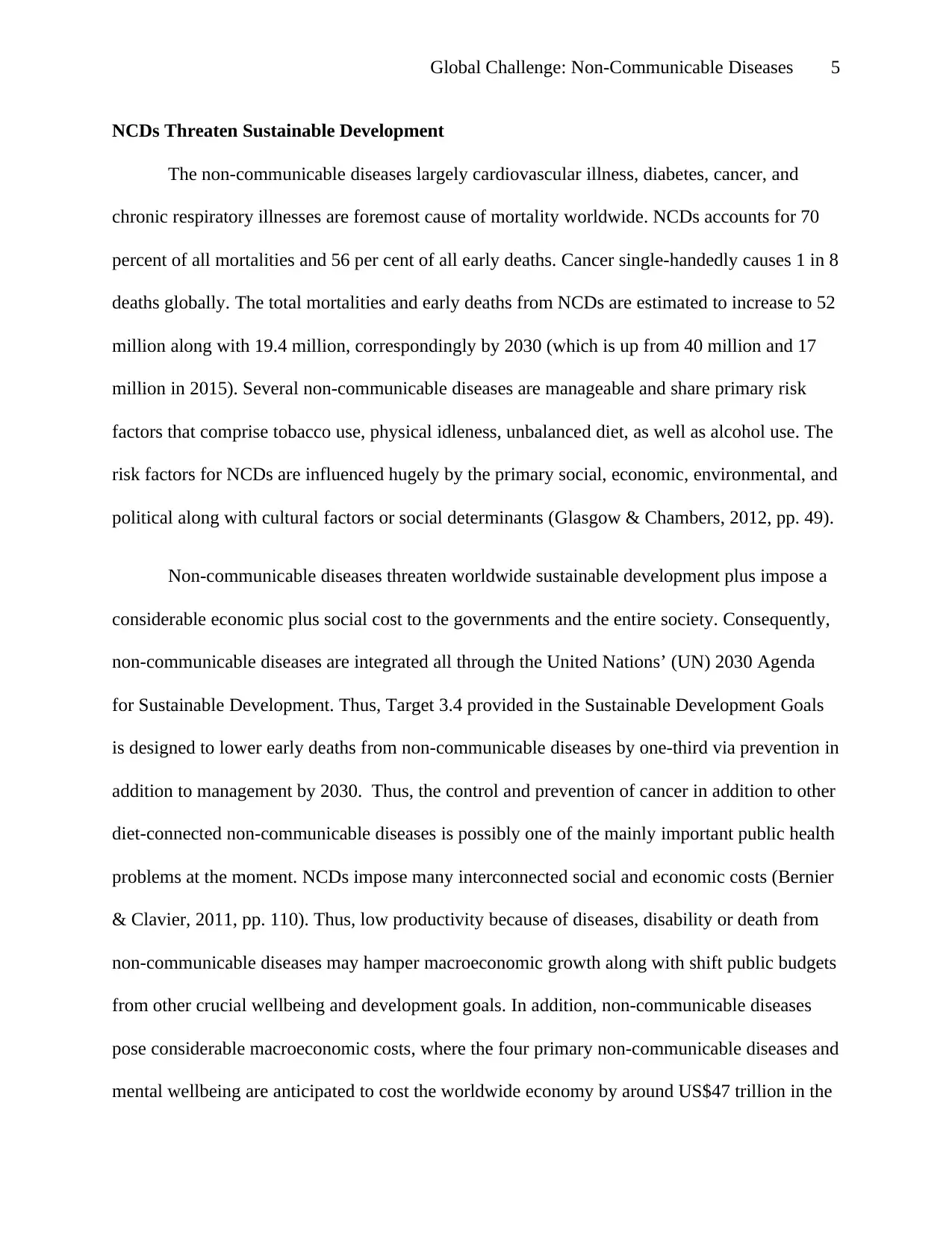
Global Challenge: Non-Communicable Diseases 5
NCDs Threaten Sustainable Development
The non-communicable diseases largely cardiovascular illness, diabetes, cancer, and
chronic respiratory illnesses are foremost cause of mortality worldwide. NCDs accounts for 70
percent of all mortalities and 56 per cent of all early deaths. Cancer single-handedly causes 1 in 8
deaths globally. The total mortalities and early deaths from NCDs are estimated to increase to 52
million along with 19.4 million, correspondingly by 2030 (which is up from 40 million and 17
million in 2015). Several non-communicable diseases are manageable and share primary risk
factors that comprise tobacco use, physical idleness, unbalanced diet, as well as alcohol use. The
risk factors for NCDs are influenced hugely by the primary social, economic, environmental, and
political along with cultural factors or social determinants (Glasgow & Chambers, 2012, pp. 49).
Non-communicable diseases threaten worldwide sustainable development plus impose a
considerable economic plus social cost to the governments and the entire society. Consequently,
non-communicable diseases are integrated all through the United Nations’ (UN) 2030 Agenda
for Sustainable Development. Thus, Target 3.4 provided in the Sustainable Development Goals
is designed to lower early deaths from non-communicable diseases by one-third via prevention in
addition to management by 2030. Thus, the control and prevention of cancer in addition to other
diet-connected non-communicable diseases is possibly one of the mainly important public health
problems at the moment. NCDs impose many interconnected social and economic costs (Bernier
& Clavier, 2011, pp. 110). Thus, low productivity because of diseases, disability or death from
non-communicable diseases may hamper macroeconomic growth along with shift public budgets
from other crucial wellbeing and development goals. In addition, non-communicable diseases
pose considerable macroeconomic costs, where the four primary non-communicable diseases and
mental wellbeing are anticipated to cost the worldwide economy by around US$47 trillion in the
NCDs Threaten Sustainable Development
The non-communicable diseases largely cardiovascular illness, diabetes, cancer, and
chronic respiratory illnesses are foremost cause of mortality worldwide. NCDs accounts for 70
percent of all mortalities and 56 per cent of all early deaths. Cancer single-handedly causes 1 in 8
deaths globally. The total mortalities and early deaths from NCDs are estimated to increase to 52
million along with 19.4 million, correspondingly by 2030 (which is up from 40 million and 17
million in 2015). Several non-communicable diseases are manageable and share primary risk
factors that comprise tobacco use, physical idleness, unbalanced diet, as well as alcohol use. The
risk factors for NCDs are influenced hugely by the primary social, economic, environmental, and
political along with cultural factors or social determinants (Glasgow & Chambers, 2012, pp. 49).
Non-communicable diseases threaten worldwide sustainable development plus impose a
considerable economic plus social cost to the governments and the entire society. Consequently,
non-communicable diseases are integrated all through the United Nations’ (UN) 2030 Agenda
for Sustainable Development. Thus, Target 3.4 provided in the Sustainable Development Goals
is designed to lower early deaths from non-communicable diseases by one-third via prevention in
addition to management by 2030. Thus, the control and prevention of cancer in addition to other
diet-connected non-communicable diseases is possibly one of the mainly important public health
problems at the moment. NCDs impose many interconnected social and economic costs (Bernier
& Clavier, 2011, pp. 110). Thus, low productivity because of diseases, disability or death from
non-communicable diseases may hamper macroeconomic growth along with shift public budgets
from other crucial wellbeing and development goals. In addition, non-communicable diseases
pose considerable macroeconomic costs, where the four primary non-communicable diseases and
mental wellbeing are anticipated to cost the worldwide economy by around US$47 trillion in the
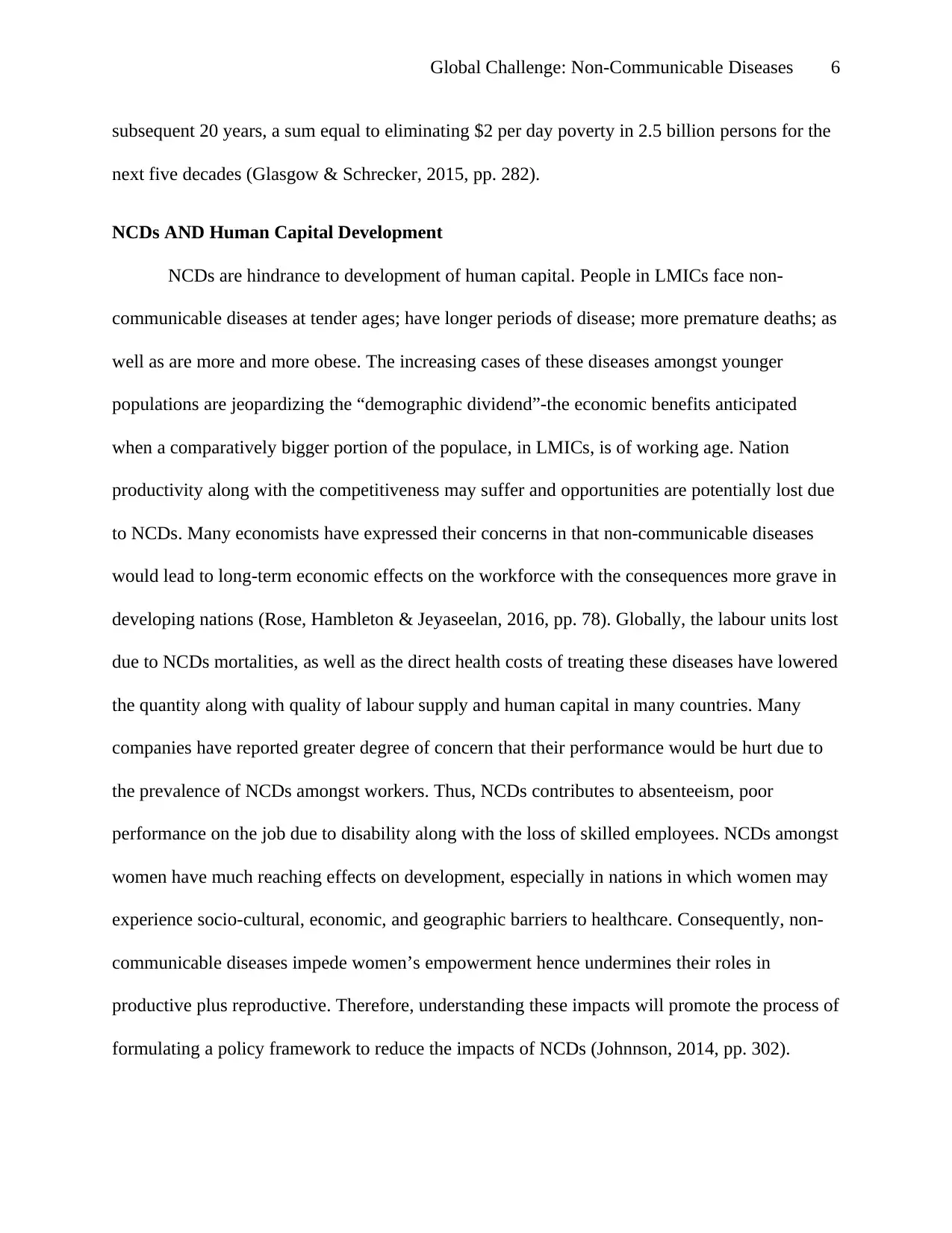
Global Challenge: Non-Communicable Diseases 6
subsequent 20 years, a sum equal to eliminating $2 per day poverty in 2.5 billion persons for the
next five decades (Glasgow & Schrecker, 2015, pp. 282).
NCDs AND Human Capital Development
NCDs are hindrance to development of human capital. People in LMICs face non-
communicable diseases at tender ages; have longer periods of disease; more premature deaths; as
well as are more and more obese. The increasing cases of these diseases amongst younger
populations are jeopardizing the “demographic dividend”-the economic benefits anticipated
when a comparatively bigger portion of the populace, in LMICs, is of working age. Nation
productivity along with the competitiveness may suffer and opportunities are potentially lost due
to NCDs. Many economists have expressed their concerns in that non-communicable diseases
would lead to long-term economic effects on the workforce with the consequences more grave in
developing nations (Rose, Hambleton & Jeyaseelan, 2016, pp. 78). Globally, the labour units lost
due to NCDs mortalities, as well as the direct health costs of treating these diseases have lowered
the quantity along with quality of labour supply and human capital in many countries. Many
companies have reported greater degree of concern that their performance would be hurt due to
the prevalence of NCDs amongst workers. Thus, NCDs contributes to absenteeism, poor
performance on the job due to disability along with the loss of skilled employees. NCDs amongst
women have much reaching effects on development, especially in nations in which women may
experience socio-cultural, economic, and geographic barriers to healthcare. Consequently, non-
communicable diseases impede women’s empowerment hence undermines their roles in
productive plus reproductive. Therefore, understanding these impacts will promote the process of
formulating a policy framework to reduce the impacts of NCDs (Johnnson, 2014, pp. 302).
subsequent 20 years, a sum equal to eliminating $2 per day poverty in 2.5 billion persons for the
next five decades (Glasgow & Schrecker, 2015, pp. 282).
NCDs AND Human Capital Development
NCDs are hindrance to development of human capital. People in LMICs face non-
communicable diseases at tender ages; have longer periods of disease; more premature deaths; as
well as are more and more obese. The increasing cases of these diseases amongst younger
populations are jeopardizing the “demographic dividend”-the economic benefits anticipated
when a comparatively bigger portion of the populace, in LMICs, is of working age. Nation
productivity along with the competitiveness may suffer and opportunities are potentially lost due
to NCDs. Many economists have expressed their concerns in that non-communicable diseases
would lead to long-term economic effects on the workforce with the consequences more grave in
developing nations (Rose, Hambleton & Jeyaseelan, 2016, pp. 78). Globally, the labour units lost
due to NCDs mortalities, as well as the direct health costs of treating these diseases have lowered
the quantity along with quality of labour supply and human capital in many countries. Many
companies have reported greater degree of concern that their performance would be hurt due to
the prevalence of NCDs amongst workers. Thus, NCDs contributes to absenteeism, poor
performance on the job due to disability along with the loss of skilled employees. NCDs amongst
women have much reaching effects on development, especially in nations in which women may
experience socio-cultural, economic, and geographic barriers to healthcare. Consequently, non-
communicable diseases impede women’s empowerment hence undermines their roles in
productive plus reproductive. Therefore, understanding these impacts will promote the process of
formulating a policy framework to reduce the impacts of NCDs (Johnnson, 2014, pp. 302).
⊘ This is a preview!⊘
Do you want full access?
Subscribe today to unlock all pages.

Trusted by 1+ million students worldwide
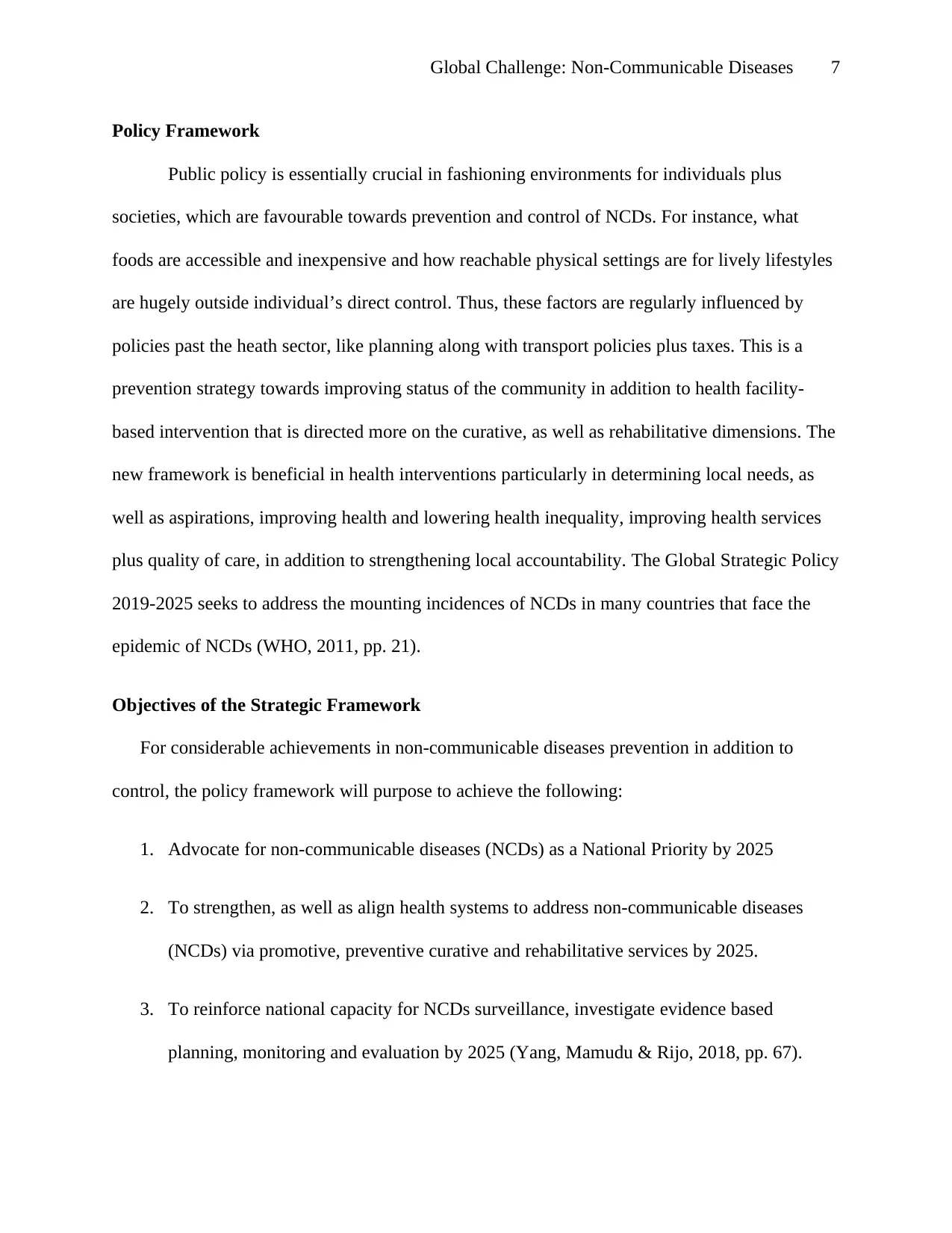
Global Challenge: Non-Communicable Diseases 7
Policy Framework
Public policy is essentially crucial in fashioning environments for individuals plus
societies, which are favourable towards prevention and control of NCDs. For instance, what
foods are accessible and inexpensive and how reachable physical settings are for lively lifestyles
are hugely outside individual’s direct control. Thus, these factors are regularly influenced by
policies past the heath sector, like planning along with transport policies plus taxes. This is a
prevention strategy towards improving status of the community in addition to health facility-
based intervention that is directed more on the curative, as well as rehabilitative dimensions. The
new framework is beneficial in health interventions particularly in determining local needs, as
well as aspirations, improving health and lowering health inequality, improving health services
plus quality of care, in addition to strengthening local accountability. The Global Strategic Policy
2019-2025 seeks to address the mounting incidences of NCDs in many countries that face the
epidemic of NCDs (WHO, 2011, pp. 21).
Objectives of the Strategic Framework
For considerable achievements in non-communicable diseases prevention in addition to
control, the policy framework will purpose to achieve the following:
1. Advocate for non-communicable diseases (NCDs) as a National Priority by 2025
2. To strengthen, as well as align health systems to address non-communicable diseases
(NCDs) via promotive, preventive curative and rehabilitative services by 2025.
3. To reinforce national capacity for NCDs surveillance, investigate evidence based
planning, monitoring and evaluation by 2025 (Yang, Mamudu & Rijo, 2018, pp. 67).
Policy Framework
Public policy is essentially crucial in fashioning environments for individuals plus
societies, which are favourable towards prevention and control of NCDs. For instance, what
foods are accessible and inexpensive and how reachable physical settings are for lively lifestyles
are hugely outside individual’s direct control. Thus, these factors are regularly influenced by
policies past the heath sector, like planning along with transport policies plus taxes. This is a
prevention strategy towards improving status of the community in addition to health facility-
based intervention that is directed more on the curative, as well as rehabilitative dimensions. The
new framework is beneficial in health interventions particularly in determining local needs, as
well as aspirations, improving health and lowering health inequality, improving health services
plus quality of care, in addition to strengthening local accountability. The Global Strategic Policy
2019-2025 seeks to address the mounting incidences of NCDs in many countries that face the
epidemic of NCDs (WHO, 2011, pp. 21).
Objectives of the Strategic Framework
For considerable achievements in non-communicable diseases prevention in addition to
control, the policy framework will purpose to achieve the following:
1. Advocate for non-communicable diseases (NCDs) as a National Priority by 2025
2. To strengthen, as well as align health systems to address non-communicable diseases
(NCDs) via promotive, preventive curative and rehabilitative services by 2025.
3. To reinforce national capacity for NCDs surveillance, investigate evidence based
planning, monitoring and evaluation by 2025 (Yang, Mamudu & Rijo, 2018, pp. 67).
Paraphrase This Document
Need a fresh take? Get an instant paraphrase of this document with our AI Paraphraser
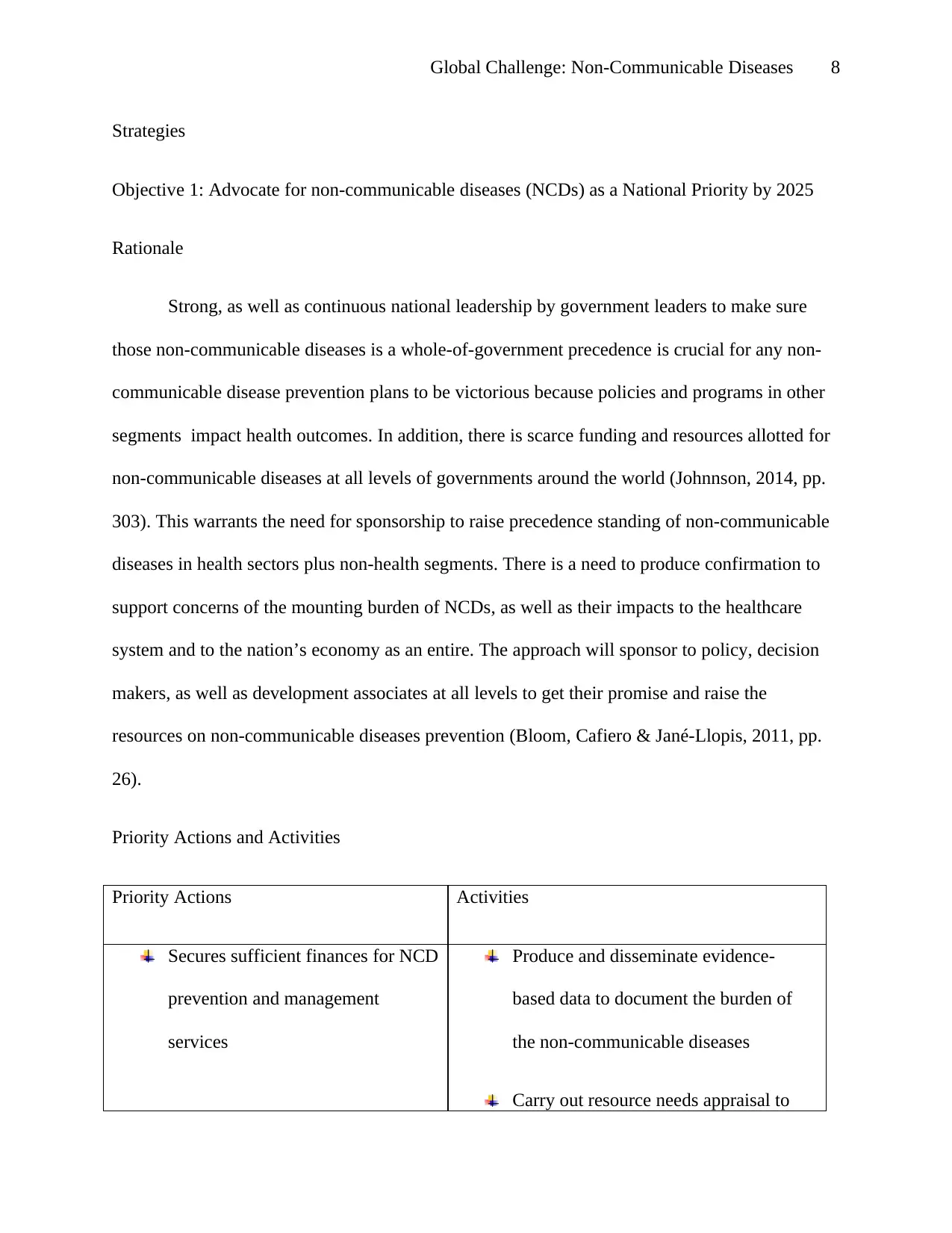
Global Challenge: Non-Communicable Diseases 8
Strategies
Objective 1: Advocate for non-communicable diseases (NCDs) as a National Priority by 2025
Rationale
Strong, as well as continuous national leadership by government leaders to make sure
those non-communicable diseases is a whole-of-government precedence is crucial for any non-
communicable disease prevention plans to be victorious because policies and programs in other
segments impact health outcomes. In addition, there is scarce funding and resources allotted for
non-communicable diseases at all levels of governments around the world (Johnnson, 2014, pp.
303). This warrants the need for sponsorship to raise precedence standing of non-communicable
diseases in health sectors plus non-health segments. There is a need to produce confirmation to
support concerns of the mounting burden of NCDs, as well as their impacts to the healthcare
system and to the nation’s economy as an entire. The approach will sponsor to policy, decision
makers, as well as development associates at all levels to get their promise and raise the
resources on non-communicable diseases prevention (Bloom, Cafiero & Jané-Llopis, 2011, pp.
26).
Priority Actions and Activities
Priority Actions Activities
Secures sufficient finances for NCD
prevention and management
services
Produce and disseminate evidence-
based data to document the burden of
the non-communicable diseases
Carry out resource needs appraisal to
Strategies
Objective 1: Advocate for non-communicable diseases (NCDs) as a National Priority by 2025
Rationale
Strong, as well as continuous national leadership by government leaders to make sure
those non-communicable diseases is a whole-of-government precedence is crucial for any non-
communicable disease prevention plans to be victorious because policies and programs in other
segments impact health outcomes. In addition, there is scarce funding and resources allotted for
non-communicable diseases at all levels of governments around the world (Johnnson, 2014, pp.
303). This warrants the need for sponsorship to raise precedence standing of non-communicable
diseases in health sectors plus non-health segments. There is a need to produce confirmation to
support concerns of the mounting burden of NCDs, as well as their impacts to the healthcare
system and to the nation’s economy as an entire. The approach will sponsor to policy, decision
makers, as well as development associates at all levels to get their promise and raise the
resources on non-communicable diseases prevention (Bloom, Cafiero & Jané-Llopis, 2011, pp.
26).
Priority Actions and Activities
Priority Actions Activities
Secures sufficient finances for NCD
prevention and management
services
Produce and disseminate evidence-
based data to document the burden of
the non-communicable diseases
Carry out resource needs appraisal to
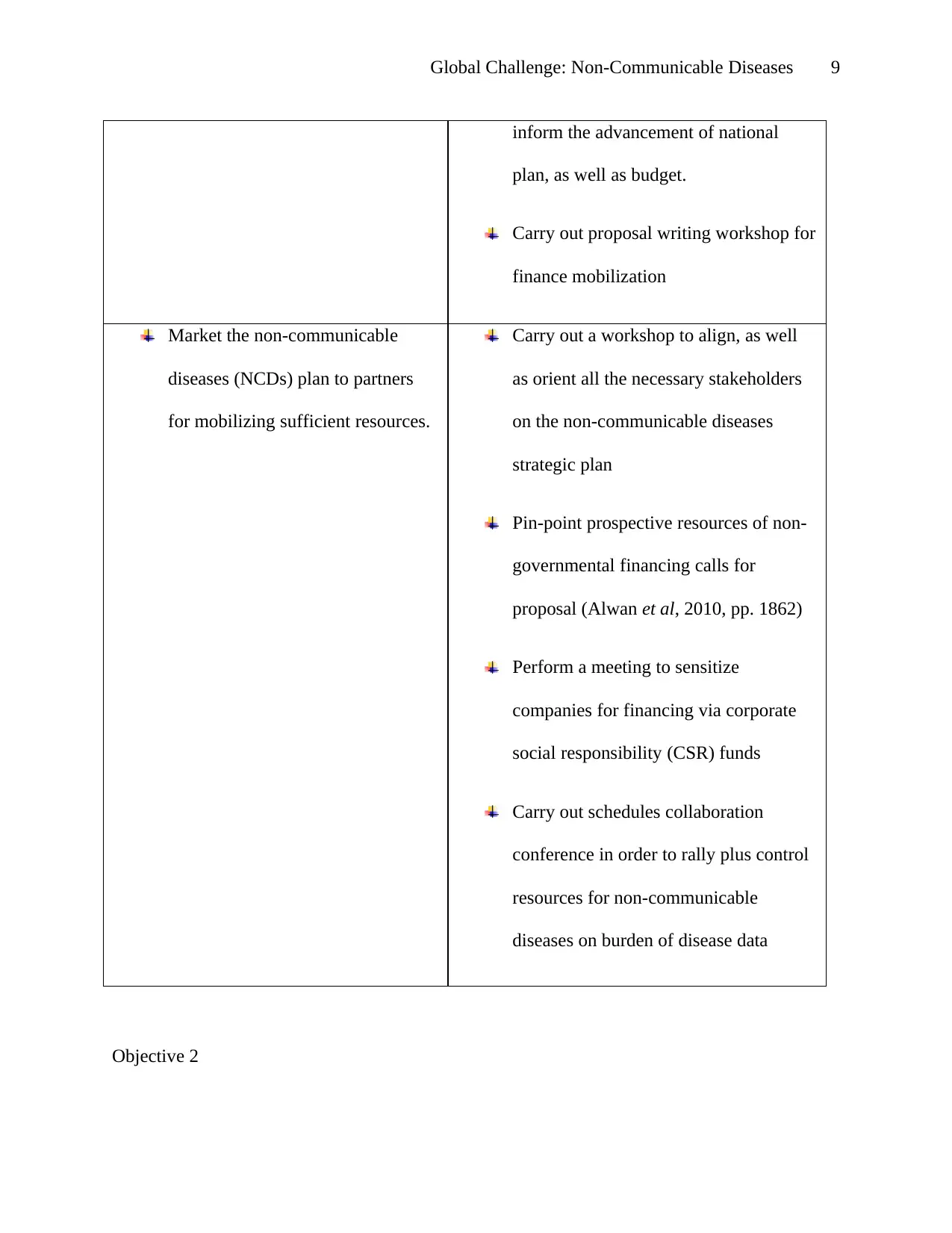
Global Challenge: Non-Communicable Diseases 9
inform the advancement of national
plan, as well as budget.
Carry out proposal writing workshop for
finance mobilization
Market the non-communicable
diseases (NCDs) plan to partners
for mobilizing sufficient resources.
Carry out a workshop to align, as well
as orient all the necessary stakeholders
on the non-communicable diseases
strategic plan
Pin-point prospective resources of non-
governmental financing calls for
proposal (Alwan et al, 2010, pp. 1862)
Perform a meeting to sensitize
companies for financing via corporate
social responsibility (CSR) funds
Carry out schedules collaboration
conference in order to rally plus control
resources for non-communicable
diseases on burden of disease data
Objective 2
inform the advancement of national
plan, as well as budget.
Carry out proposal writing workshop for
finance mobilization
Market the non-communicable
diseases (NCDs) plan to partners
for mobilizing sufficient resources.
Carry out a workshop to align, as well
as orient all the necessary stakeholders
on the non-communicable diseases
strategic plan
Pin-point prospective resources of non-
governmental financing calls for
proposal (Alwan et al, 2010, pp. 1862)
Perform a meeting to sensitize
companies for financing via corporate
social responsibility (CSR) funds
Carry out schedules collaboration
conference in order to rally plus control
resources for non-communicable
diseases on burden of disease data
Objective 2
⊘ This is a preview!⊘
Do you want full access?
Subscribe today to unlock all pages.

Trusted by 1+ million students worldwide
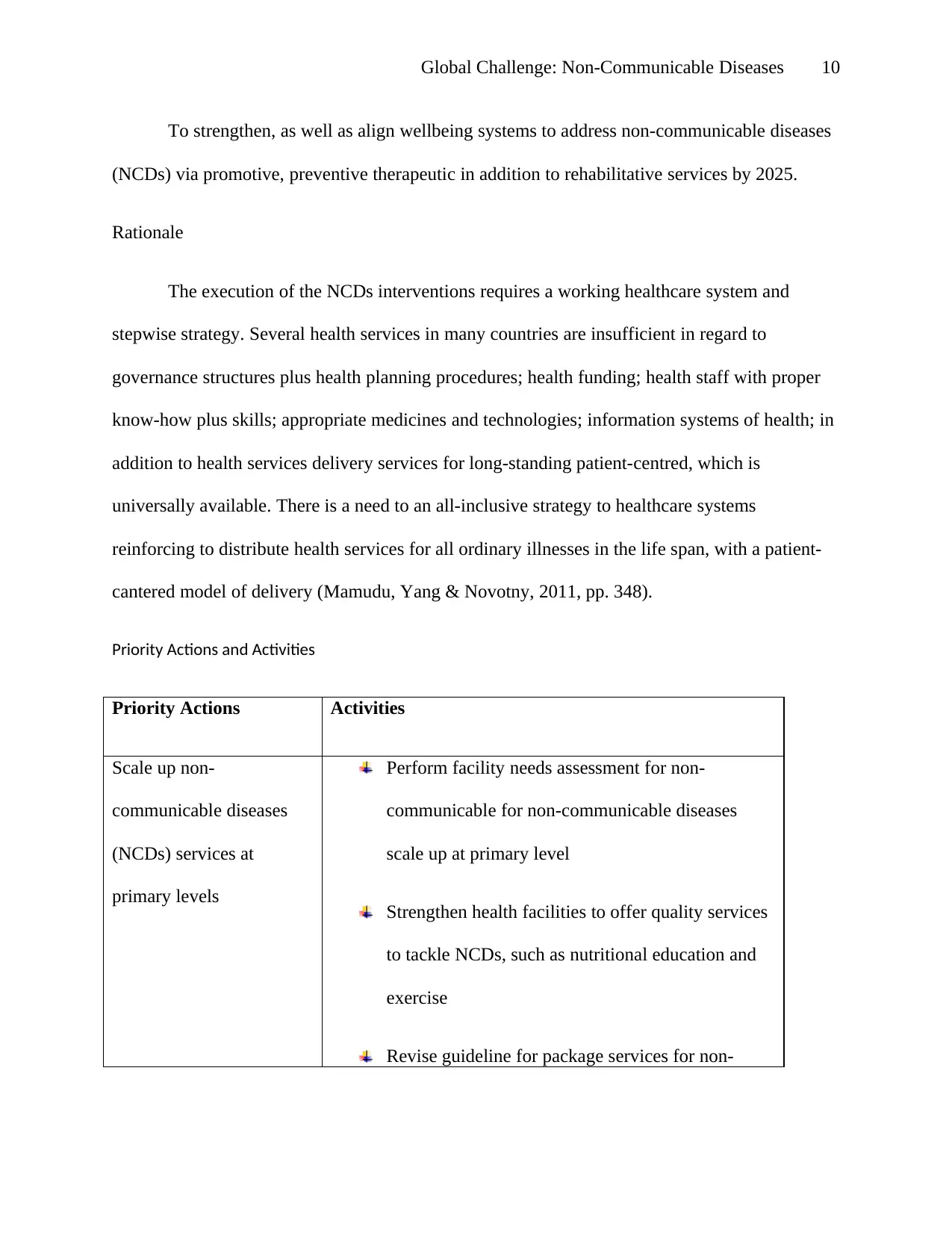
Global Challenge: Non-Communicable Diseases 10
To strengthen, as well as align wellbeing systems to address non-communicable diseases
(NCDs) via promotive, preventive therapeutic in addition to rehabilitative services by 2025.
Rationale
The execution of the NCDs interventions requires a working healthcare system and
stepwise strategy. Several health services in many countries are insufficient in regard to
governance structures plus health planning procedures; health funding; health staff with proper
know-how plus skills; appropriate medicines and technologies; information systems of health; in
addition to health services delivery services for long-standing patient-centred, which is
universally available. There is a need to an all-inclusive strategy to healthcare systems
reinforcing to distribute health services for all ordinary illnesses in the life span, with a patient-
cantered model of delivery (Mamudu, Yang & Novotny, 2011, pp. 348).
Priority Actions and Activities
Priority Actions Activities
Scale up non-
communicable diseases
(NCDs) services at
primary levels
Perform facility needs assessment for non-
communicable for non-communicable diseases
scale up at primary level
Strengthen health facilities to offer quality services
to tackle NCDs, such as nutritional education and
exercise
Revise guideline for package services for non-
To strengthen, as well as align wellbeing systems to address non-communicable diseases
(NCDs) via promotive, preventive therapeutic in addition to rehabilitative services by 2025.
Rationale
The execution of the NCDs interventions requires a working healthcare system and
stepwise strategy. Several health services in many countries are insufficient in regard to
governance structures plus health planning procedures; health funding; health staff with proper
know-how plus skills; appropriate medicines and technologies; information systems of health; in
addition to health services delivery services for long-standing patient-centred, which is
universally available. There is a need to an all-inclusive strategy to healthcare systems
reinforcing to distribute health services for all ordinary illnesses in the life span, with a patient-
cantered model of delivery (Mamudu, Yang & Novotny, 2011, pp. 348).
Priority Actions and Activities
Priority Actions Activities
Scale up non-
communicable diseases
(NCDs) services at
primary levels
Perform facility needs assessment for non-
communicable for non-communicable diseases
scale up at primary level
Strengthen health facilities to offer quality services
to tackle NCDs, such as nutritional education and
exercise
Revise guideline for package services for non-
Paraphrase This Document
Need a fresh take? Get an instant paraphrase of this document with our AI Paraphraser
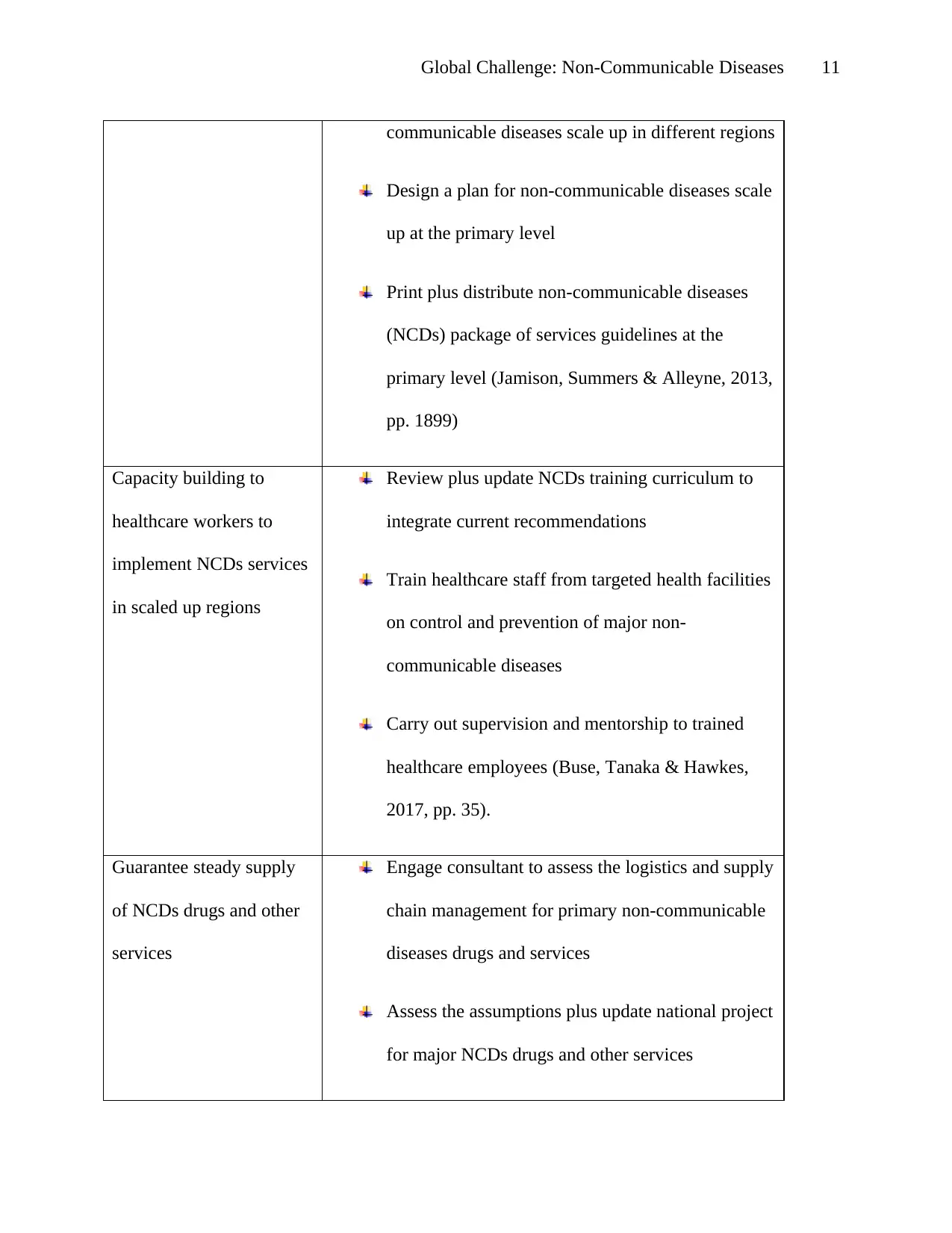
Global Challenge: Non-Communicable Diseases 11
communicable diseases scale up in different regions
Design a plan for non-communicable diseases scale
up at the primary level
Print plus distribute non-communicable diseases
(NCDs) package of services guidelines at the
primary level (Jamison, Summers & Alleyne, 2013,
pp. 1899)
Capacity building to
healthcare workers to
implement NCDs services
in scaled up regions
Review plus update NCDs training curriculum to
integrate current recommendations
Train healthcare staff from targeted health facilities
on control and prevention of major non-
communicable diseases
Carry out supervision and mentorship to trained
healthcare employees (Buse, Tanaka & Hawkes,
2017, pp. 35).
Guarantee steady supply
of NCDs drugs and other
services
Engage consultant to assess the logistics and supply
chain management for primary non-communicable
diseases drugs and services
Assess the assumptions plus update national project
for major NCDs drugs and other services
communicable diseases scale up in different regions
Design a plan for non-communicable diseases scale
up at the primary level
Print plus distribute non-communicable diseases
(NCDs) package of services guidelines at the
primary level (Jamison, Summers & Alleyne, 2013,
pp. 1899)
Capacity building to
healthcare workers to
implement NCDs services
in scaled up regions
Review plus update NCDs training curriculum to
integrate current recommendations
Train healthcare staff from targeted health facilities
on control and prevention of major non-
communicable diseases
Carry out supervision and mentorship to trained
healthcare employees (Buse, Tanaka & Hawkes,
2017, pp. 35).
Guarantee steady supply
of NCDs drugs and other
services
Engage consultant to assess the logistics and supply
chain management for primary non-communicable
diseases drugs and services
Assess the assumptions plus update national project
for major NCDs drugs and other services
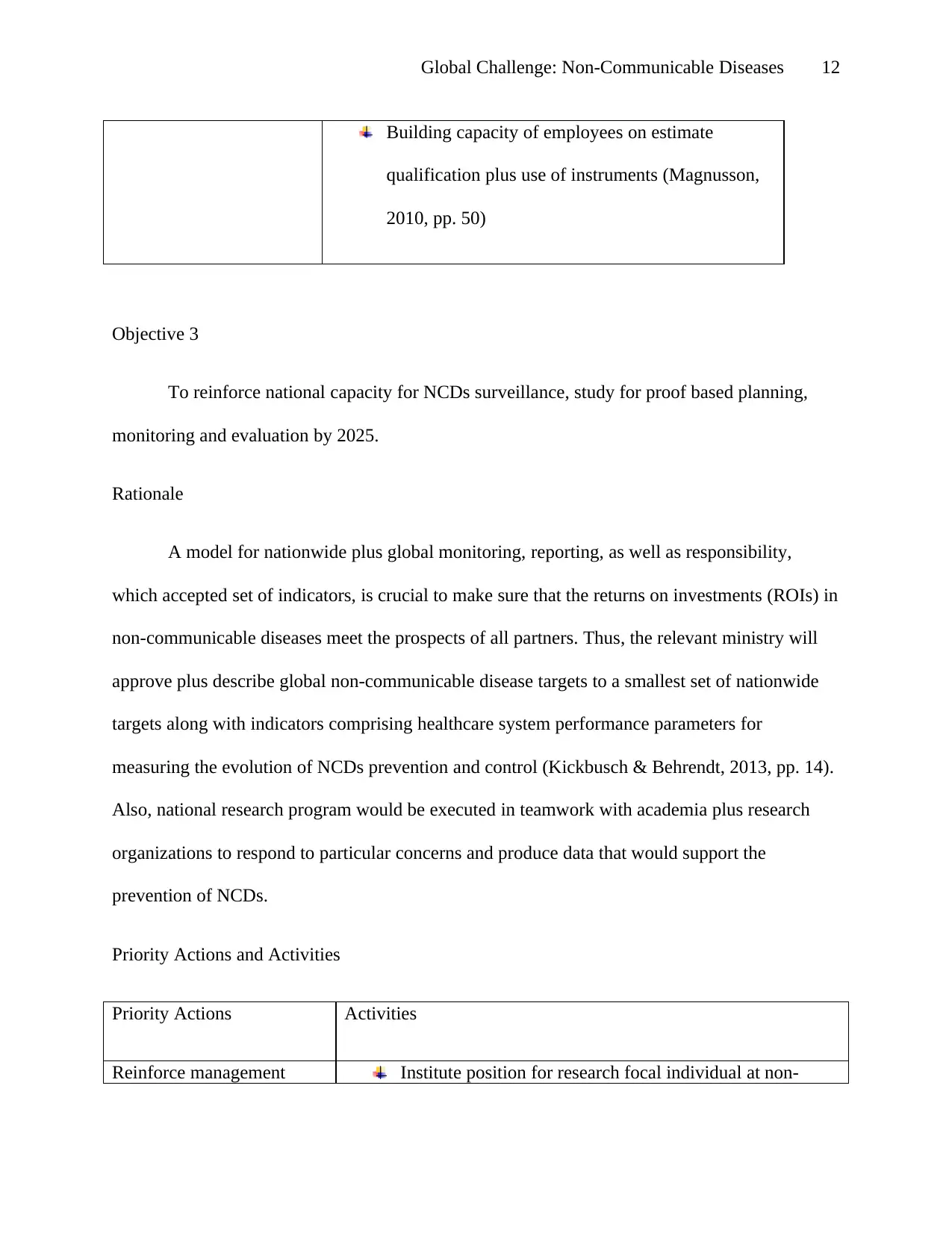
Global Challenge: Non-Communicable Diseases 12
Building capacity of employees on estimate
qualification plus use of instruments (Magnusson,
2010, pp. 50)
Objective 3
To reinforce national capacity for NCDs surveillance, study for proof based planning,
monitoring and evaluation by 2025.
Rationale
A model for nationwide plus global monitoring, reporting, as well as responsibility,
which accepted set of indicators, is crucial to make sure that the returns on investments (ROIs) in
non-communicable diseases meet the prospects of all partners. Thus, the relevant ministry will
approve plus describe global non-communicable disease targets to a smallest set of nationwide
targets along with indicators comprising healthcare system performance parameters for
measuring the evolution of NCDs prevention and control (Kickbusch & Behrendt, 2013, pp. 14).
Also, national research program would be executed in teamwork with academia plus research
organizations to respond to particular concerns and produce data that would support the
prevention of NCDs.
Priority Actions and Activities
Priority Actions Activities
Reinforce management Institute position for research focal individual at non-
Building capacity of employees on estimate
qualification plus use of instruments (Magnusson,
2010, pp. 50)
Objective 3
To reinforce national capacity for NCDs surveillance, study for proof based planning,
monitoring and evaluation by 2025.
Rationale
A model for nationwide plus global monitoring, reporting, as well as responsibility,
which accepted set of indicators, is crucial to make sure that the returns on investments (ROIs) in
non-communicable diseases meet the prospects of all partners. Thus, the relevant ministry will
approve plus describe global non-communicable disease targets to a smallest set of nationwide
targets along with indicators comprising healthcare system performance parameters for
measuring the evolution of NCDs prevention and control (Kickbusch & Behrendt, 2013, pp. 14).
Also, national research program would be executed in teamwork with academia plus research
organizations to respond to particular concerns and produce data that would support the
prevention of NCDs.
Priority Actions and Activities
Priority Actions Activities
Reinforce management Institute position for research focal individual at non-
⊘ This is a preview!⊘
Do you want full access?
Subscribe today to unlock all pages.

Trusted by 1+ million students worldwide
1 out of 20
Related Documents
Your All-in-One AI-Powered Toolkit for Academic Success.
+13062052269
info@desklib.com
Available 24*7 on WhatsApp / Email
![[object Object]](/_next/static/media/star-bottom.7253800d.svg)
Unlock your academic potential
Copyright © 2020–2025 A2Z Services. All Rights Reserved. Developed and managed by ZUCOL.





